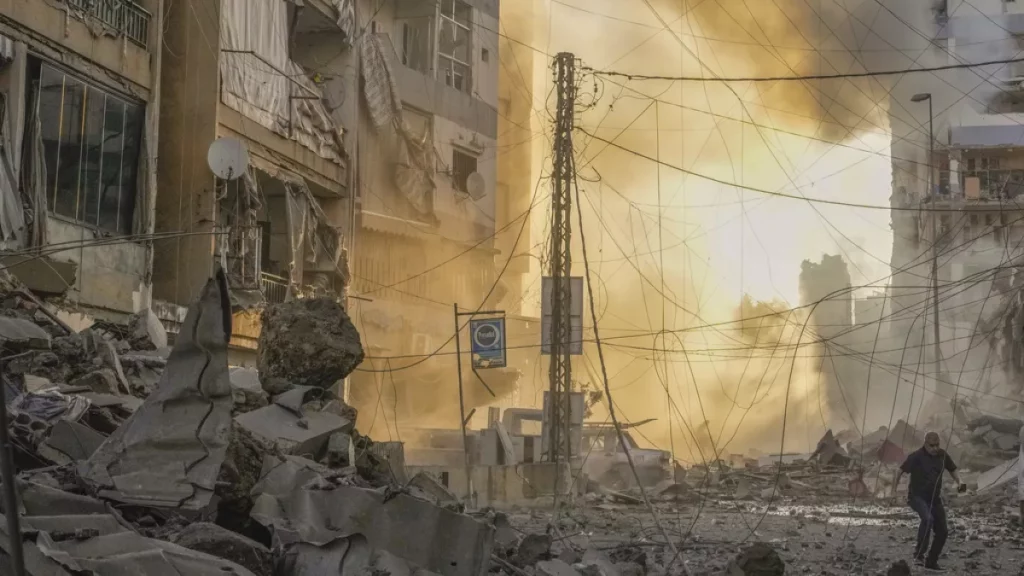In the last 24 hours, Israel has issued more than 20 evacuation orders in southern Beirut, home to tens of thousands of people.
Videos circulating on social media show a massive wave of displacement from neighborhoods like Ghobeiry and Chiyah in Dahiyeh, where airstrikes have intensified in recent days.
The constant barrage of orders, the widespread areas targeted, and the intensity of Israeli airstrikes point to an escalation far beyond anything Beirut faced during the 2006 war.
Civilians have not been spared. Israeli airstrikes have leveled residential buildings, decimated entire towns, and forced more than 1.2 million people, mainly from Shia Muslim areas, to flee.
Hundreds of families from Dahiyeh are now without shelter, as many Lebanese households hesitate to take in displaced Shia families, fearing they could become Israeli targets. With few options left, some are living on the streets, while others seek refuge in abandoned buildings, making do with whatever they can find.
Untouched neighborhoods now face relentless strikes
Among the displaced in Dahiyeh are Lebanese who vividly remember the month-long 2006 war, when Israeli strikes turned much of Beirut’s suburbs to rubble.
At that time, Dahiyeh endured five weeks of heavy bombardment, though it was less frequent and intense than today and concentrated on a smaller area. The strikes reached the vicinity of the airport and two of the city’s lighthouses but did not extend nearly as far as they do now.
For the first time, neighborhoods across central Beirut and the southern suburbs – Ghobeiry, Hadath, St. Therese, Chiyah, Ouzai, Laylaki, Basta, Ras el Nabeh, Cola, and Bachoura – are under relentless attack, areas that were untouched in 2006.
The toll back in 2006 was already devastating: around 1,200 people were killed in Lebanon, nearly 4,500 were injured, and a million were temporarily displaced, according to the ICRC.
Now, the numbers have surged even further. Since October 2023, around 3,300 people have been killed, 14,300 have been injured, and nearly 1.2 million people across Lebanon have been forced from their homes – a number that continues to climb with each new evacuation order and airstrike.
Displaced forced to sleep in streets as shelters fill
The first major exodus from Dahiyeh occurred on September 28, when Israeli forces dropped 80 bombs on residential buildings, killing Hezbollah’s leader, Hassan Nasrallah, and an unknown number of civilians.
Later that night, Israel issued several evacuation orders via social media, prompting thousands of civilians to flee their homes in fear and seek refuge across Beirut.
Despite the mass displacement, only about 190,000 of the displaced have found shelter in organized facilities, according to an Al Jazeera report from October 19. The majority are left to find refuge wherever they can.
Tens of thousands have sought refuge in schools that Lebanon’s caretaker government has converted into shelters. But as space fills up, many have no choice but to squat in abandoned buildings or sleep in public spaces, such as outside mosques or on pavements.
With winter approaching and ceasefire talks remaining uncertain, many displaced families are bracing for a harsh winter with no truce in sight.
“There’s a lot of discrimination”
Finding available apartments for displaced individuals has become increasingly difficult, according to Soha Mneimneh, urban planner and co-coordinator of the initiative Sakf1, which translates to “One Roof.”
The group of activists began assisting displaced individuals and families fleeing the south due to the conflict between Hezbollah and Israel, as well as the rising cost of rent.
However, Sakf1 has encountered significant challenges with discrimination, as some landlords refuse to rent out their spaces due to assumptions about the displaced individuals’ affiliation with Hezbollah.
“Many host communities are now hesitant to open their homes to displaced families, fearing that their guests may become targets of Israel,” says Mneimneh from Sakf1 to Beirut Today.
To address this issue, the team is working to educate people against discrimination based on appearances, stressing that wearing a veil doesn’t indicate Hezbollah affiliation and that support for the group doesn’t necessarily imply active involvement.
“There’s a lot of discrimination, that’s for sure,” Mneimneh says.
The team acknowledges that they cannot guarantee the background or intentions of the displaced individuals, meaning the final decision to rent rests with the property owners.
Christian guards patrol neighborhoods for Hezbollah infiltrators
Each evening, a group of guards patrols the predominantly Christian neighborhood of Ashrafieh in Beirut. Armed with flashlights and batons, they stay hidden in plain sight, remaining on high alert for anyone who seems out of place, according to NPR.
“We’re anxious. We see new people and try to check on them discreetly,” Kamil Helou, who oversees some of the night watches, said in an interview with NPR.
“You don’t know who your new neighbor is. They might be a target.”
Nadim Gemayel, a right-wing member of parliament and founder of the organization behind the neighborhood watch program, told NPR that the circumstances require their patrols to be more attuned than ever, as there is a deep fear of Hezbollah members hiding in some properties.
If anything raises suspicion, the guards gather information quietly before contacting the Lebanese Armed Forces for further investigation.
This fear is spreading beyond Ashrafieh, reaching other Christian areas of Beirut. Elee Jaber, who manages a family-owned bakery in Ain El Remmaneh, near Dahiyeh, told NPR:
“For children and women, we welcome everyone, but we’re on high alert for every man coming into our neighborhood.”
Jaber stressed that the locals’ intention is not to discriminate, but to take necessary precautions.
As Israel continues to strike Dahiyeh heavily and temperatures drop with no ceasefire in sight, displaced families, now without homes, face an ever-growing threat of exposure. In the midst of this uncertainty, survival has become their only reality, as they wait for a peace that may never come.
